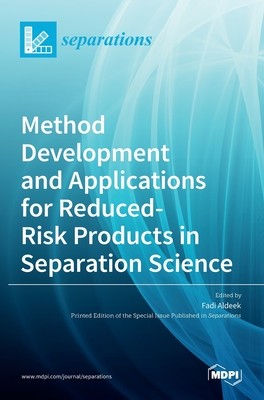
- We will send in 10–14 business days.
- Publisher: MDPI AG
- ISBN-10: 303653637X
- ISBN-13: 9783036536378
- Format: 17 x 24.4 x 1.4 cm, hardcover
- Language: English
- SAVE -10% with code: EXTRA
Method Development and Applications for Reduced-Risk Products in Separation Science (e-book) (used book) | bookbook.eu
Reviews
Description
In recent years, there has been rapid growth in the availability of innovative, non-combustible products, including oral tobacco-derived nicotine (OTDN) products, heated tobacco products (HTPs), and electronic cigarettes (also referred to as e-vapor products; EVPs).
Industry, academic, and government researchers are developing and validating analytical methods to extract, separate, identify, and quantitate a variety of analytes from these innovative tobacco products using a wide range of analytical techniques. These analytes include constituents such as nicotine, degradants and impurities, flavors, non-tobacco ingredients, HPHCs, and other currently unknown constituents.
In this Special Issue, we received nine contributions that covered the latest analytical methods that have been developed and applied for the chemical characterization or exposure assessment to tobacco product constituents of innovative non-combustible products.
This Special Issue is representative of the importance of analytical sciences research in characterizing innovative non-combustible products for guiding product design, determining relative product performance, ensuring consistency during the manufacturing process, informing toxicological risk assessment, and enabling regulatory reporting. The current advances in the development and applications of the analytical methods reported in this Special Issue can be used to inform the harm reduction potential of innovative non-combustible products for adult smokers.
EXTRA 10 % discount with code: EXTRA
The promotion ends in 10d.13:25:32
The discount code is valid when purchasing from 10 €. Discounts do not stack.
- Publisher: MDPI AG
- ISBN-10: 303653637X
- ISBN-13: 9783036536378
- Format: 17 x 24.4 x 1.4 cm, hardcover
- Language: English English
In recent years, there has been rapid growth in the availability of innovative, non-combustible products, including oral tobacco-derived nicotine (OTDN) products, heated tobacco products (HTPs), and electronic cigarettes (also referred to as e-vapor products; EVPs).
Industry, academic, and government researchers are developing and validating analytical methods to extract, separate, identify, and quantitate a variety of analytes from these innovative tobacco products using a wide range of analytical techniques. These analytes include constituents such as nicotine, degradants and impurities, flavors, non-tobacco ingredients, HPHCs, and other currently unknown constituents.
In this Special Issue, we received nine contributions that covered the latest analytical methods that have been developed and applied for the chemical characterization or exposure assessment to tobacco product constituents of innovative non-combustible products.
This Special Issue is representative of the importance of analytical sciences research in characterizing innovative non-combustible products for guiding product design, determining relative product performance, ensuring consistency during the manufacturing process, informing toxicological risk assessment, and enabling regulatory reporting. The current advances in the development and applications of the analytical methods reported in this Special Issue can be used to inform the harm reduction potential of innovative non-combustible products for adult smokers.


Reviews